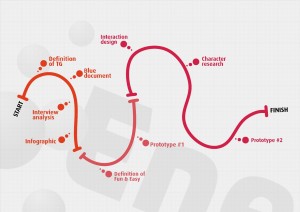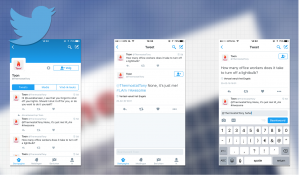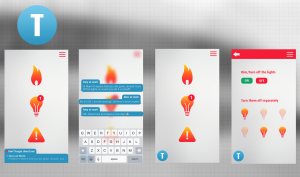Sprint 1
Three weeks ago we started our first sprint at MediaLAB Amsterdam. Our partner is Eneco, an energy company in the Netherlands. After our first meeting we already realised that Eneco is really trying to change their reputation and wants to make a transition from a commodity based company to a more service based advisory role. They want to advise and help their customers with making choices about everyday use of (sustainable) energy.
The idea of our project is to create a smart technology service to be of help for their target groups. For now they’ve already developed the Toon – a smart technology system specially designed for the home situation. Now our project revolves around implementing this system into the workspace.
For this sprint particularly we focused on the “fun & easy” part of the design of a system to make users engage more with the service. Because, when users engage more with a product, they will get more loyal towards the brand that provides it. And that’s exactly what Eneco wants.
Phase 1 – Research
Our target group is Tiny Tide Offices (TTO), that are mainly information, communication and consultancy agencies and shared offices: hubs, incubators. TTO companies consist of less than 10 people and 60-70% are 1-person companies. It means that there could be a lot of opportunities throughout the day for direct interaction with the smart system. We looked at game and fun theories to make the whole interaction enjoyable.
Phase 2 – Fun and Easy
Fun can be researched and that is what we did. Here are the results:
There are different types of fun divided into 4 categories:
- Challenging fun – objective, awards, strategy, frustration.
- People fun – generosity, niche interests, competition.
- Easy fun – surprise, discovery, curiosity, content.
- Creative fun – creativity, personalisation, avatars.
We decided to concentrate on the last two – easy and creative fun for several reasons. First, people in the business sector are more interested in their own progress, rather than how are they are doing compared to other companies. Therefore, competition-people fun was out. Secondly, the challenging fun was more related with gamification and required plenty of interaction with the whole system to completely experience this kind of fun. We made three prototypes to test whether easy and fun elements would increase engagement based only on easy and creative fun elements.
First round of prototypes
To test our sprint goal hypothesis (that fun elements increase engagement) we identified three different directions for prototypes:
- Colors, shapes and icons. It’s all about visual perception: bright colors, big buttons and small tolerance for text.
- Interaction flow. Involving a user to a journey through interface and guiding him/her through screens with a sense of flow.
- Character. Tapping into user needs and giving a sense of freedom (to delegate tasks to character) and a sense of control (to make decision him/herself) while pleasantly engaging with the character.
- The traditional, formal and slick looking as a control.
After testing all prototypes, we found that the respondents found character prototype the most engaging, fun to interact with and invoked positive emotions. The flow prototype was second favorite because of its clear interface, but the fast changing of screens made some users distracted. Based on results, we decided to explore character based interfaces furthermore.
Phase 3: Tony
And then we arrived to phase three; the creation of Tony the Thermostat. We did research considering characters in general and what different kinds of mediums (audial, visual, etc) we could use for the character itself. Additionally we performed research regarding interaction design and we tried to explore many different options. Here are some examples of Brad, Siri and Quartz:
After all this we created the second (or fifth!) prototype: an app with Tony, the character, whom you could chat with as a guide and adviser in energy usage. Furthermore, we played around with the personality of Tony by creating a Twitter account.
We would like to test if Tony makes business people engage more with the service, but before we do that we want to be prepared. So we did a pilot-test with some of the workers at Eneco to try out how exactly to test engagement. To be continued!
Further Directions
As a result we’ve generated a lot of brainstorm material, such as seeing Tony as a real colleague. For a lot of flex workers reality is that they work alone most of the time. So, to have a friendly colleague would probably be enjoyable. Really seeing Tony as a partner could mean that you could give Tony a tour around the office when it is his first day. By doing this, for example, Tony could create a virtual map of the office and use this for his job. When seeing Tony as a partner it could also mean that Tony could ‘grab lunch’ with you to go over some statistics and insights in relation to your energy usage.
Another interesting thing to explore some more is the medium of Tony. What if Tony is on the coffee machine, or on the doors? When you look at a regular thermostat it is most probably white and almost invisible. What if we make it like a functional art object? In that way, Tony could be in the center of attention, but still be invisible.
But now…
the most important thing is to focus on getting to know the real users. Their needs, their frustrations, their wants, et cetera. This means doing a lot of networking and doing interviews. Maybe we’ll find out what the subtle balance is between the freedom and control our target group wants very badly.





